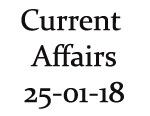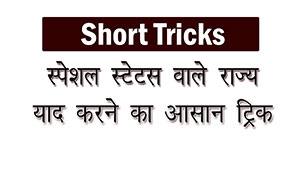-
Current Affairs 25th January 2018
Updated : 25-Jan-2018
Current Affairs 25th January 2018 - Important Points
- UNESCO Award received by - Tamil Nadu CM Edappadi K Palanichamy
- India Ranked 177 in Environmental Performance Index for - 2018
- Rank of India on Global Talent Competitiveness Index - 81
- S Somanath took charge as VSSC Director on - 22nd January 2018
- 73 new airport and helipads to be connected under Phase-2 of regional connectivity scheme UDAN on - 24th January 2018
- Smart solar windows that could produce electricity discovered by - Scientists
Current Affairs 25th January 2018 - Details
UNESCO Award received by - Tamil Nadu CM Edappadi K Palanichamy
Tamil Nadu CM Edappadi K Palanichamy got UNESCO Award of Merit awarded to the iconic Srirangam Ranganathaswamy temple in Tiruchirapalli.
The award of merit was granted by UNESCO Asia Pacific area for the re-construction schemes undertaken in temple without affecting its traditional magnificence and Vedic rituals.
Sri Ranganathaswamy Temple
It is believed as one of the chief of the 108 main Vishnu temples. It is Vaishnava temple constructed in Tamil style of construction. It is situated on an islet formed by twin rivers, Cauvery and Coleroon. The temple-premises is located in sprawling ground of over 156 acres.
The temple and 1000 pillared hall were built in the Vijayanagar period 1336 to1565 on the site of an aged temple. It has 7 prakaras. Its Gopuram also known as Raja Gopuram, is the largest gopuram in Asia. It yearly hosts 21 days festival during the Tamil month of Margazhi i.e. between December and January, which allures more than 1 million tourists.
UNESCO Asia-Pacific awards for cultural heritage conservation program
The UNESCO Asia-Pacific awards for cultural heritage conservation program is focused at accepting efforts taken to restore and preserve historical monuments without affecting their heritage ethics. The awards are categorized under 4 classes– Awards of Merit, Award for New Design, Award of Excellence and Awards of Distinction in Heritage Context.
India Ranked 177 in Environmental Performance Index for - 2018
India has been placed 177 among 180 nations in the Environmental Performance Index– 2018. This index has been formed by Yale University and Columbia University in coordination with the World Economic Forum and the Joint Research Centre of the European Commission. This report has been published on 23rd January, 2018 on the side-lines of World Economic Forum gathering in Davos.
Top and Bottom 5 Nations in 2018 EPI
- Top five nations are Switzerland, France, Denmark, Malta and Sweden.
- Top bottom nations are Nepal, India, Congo, Bangladesh, Burundi.
More about the Environment Performance Index
Environmental Performance Index is evaluated on the basis of data collected from 24 individual metrics of environmental performance. These 24-individual metrics are then segregated into a hierarchy that starts with ten major environmental problems categories.
The ten environmental problems classes are then segregated into 2 policy aims namely, Environment health and Ecosystem Vitality. The complete EPI is according to a nation’s performance in these 10 issue classes and 2 policy aims. High rank in the EPI indicates long-standing promises for preserving natural resources, protecting public health and decoupling greenhouse gas emissions from economic action.
The 2018 Report important Notes About India
- The report has placed India as 4th worst nation worldwide in curbing environmental pollution. India has fallen from 141-position in 2016 report.
- The low rank of developing economies including China- 120 and India- 177 highlights strain population pressures and rapid economic growth levy on the environment.
- According to the report, substantial populations still suffer from bad air quality, most in India, China, and Pakistan.
Rank of India on Global Talent Competitiveness Index - 81
India has been ranked 81st on the annual global index of talent competitiveness released on the first day of the 48th World Economic Forum (WEF) annual meeting held in Davos, Switzerland.
While Switzerland continues to be on top in the list whereas India has improved its position from 92nd last year. India was at the 89th rank in 2016. This index basically measures how countries grow, attract and retain talent.
Important Highlights
- Though India has improved its position in the list, it still lags behind the many other BRICS countries.
- While India was ranked the lowest in the group, China faired the best with 43rd rank, followed by Russia on 53, South Africa at 63 and Brazil on 73rd position.
- India's ranking was the worst among the five BRICS countries in 2017 as well, China, on the other hand, was still ahead with 54th rank, followed by Russia at the 56th position, South Africa at 67 and Brazil at 81.
- All the nations though have shown better performance on their positions on the global index from 2017.
- Among the top countries on the index this year, Switzerland is followed by Singapore and then the USA.
- The top ranks were mostly dominated by European countries, with 15 of them featuring in the top 25 places.
More about Global Talent Competitiveness Index
- This annual index created in partnership with Adecco, Insead and Tata Communications.
- The index is an annual report measuring the ability of countries to compete for talent.
- It aims to give governments and businesses the distilled data from 119 countries, which will be assisting the decision makers in developing strategies and talent policies that will be helping to boost their talent competitiveness.
S Somanath took charge as VSSC Director on - 22nd January 2018
Renowned scientist, S Somanath took charge as the Director of Vikram Sarabhai Space Centre (VSSC) in Thiruvananthapuram, Kerala on January 22nd, 2018.
The space centre is Indian Space Research Organisation’s lead centre to launch vehicles. Somanath took up this significant role during a function held in ISRO headquarters in Bengaluru. He succeeded K Sivan, who was recently appointed as ISRO Chairman.
More about S Somanath
- He is currently the Director of Liquid Propulsion Systems Centre Liquid Propulsion Systems Centre, which is the lead centre responsible for liquid engines and stages for ISRO's all launch vehicles and satellite programs.
- Until June 2015, he was the Associate Director (Projects) of VSSC and also the Project Director of GSLV Mk-III launch vehicle.
- Under his leadership as the Project Director, the first Experimental flight of LVM3-X/CARE mission was successfully accomplished on December 18th 2014.
- In 1985, he joined ISRO and that time he was a team leader for Integration of PSLV during its early development phase and during the first flight of PSLV as well as the successful second flight PSLV-D2.
- He handled areas of mechanisms, pyro-technique systems and satellite launch service management as a project manager.
- He conceived and executed the first time launches of commercial mini satellites and developed small satellite mounting and separation systems which successfully have deployed many commercial satellites.
- All in all, he has made significant contributions to the overall architecture, separation systems, structural and structural dynamics, propulsion systems, vehicle integration and integration procedures development of PSLV and GSLV MK III.
73 new airport and helipads to be connected under Phase-2 of regional connectivity scheme UDAN on - 24th January 2018
The Union Government on 24th January 2018 declared that 73 underserved and un-served airports and helipads will be joined under the second phase of the Ude Desh Ka Aam Nagrik- UDAN Plan, a Regional Connectivity Scheme.
Sum of 90 proposals were granted to provide flight connectivity to more than 300 regional routes. Interglobe Aviation, the parent firm of IndiGo, was granted a maximum number of 20 proposals followed by SpiceJet which won seventeen and Jet-Airways won four proposals.
For the 1st time, bids were received from helicopter operators in the phase 2 of the plan. Under the 1st round of UDAN, which ended in March 2017, a sum of total 128 routes were granted to 5 airline operators.
Highlights of the UDAN 2 Scheme- The scheme will provide approximately 26.5 lakh seats per year that will be covered with airfare cap of Rs. 2500 hourly of flying.
- In addition, approximately 2 lakh regional connectivity plan seats per year will be provided through helicopter operations.
- States with highest number of airports and helipads which will see activation in UDAN 2 scheme.
- These states includes Uttarakhand- 15 airports, Uttar Pradesh- 9 airports, Arunachal Pradesh- 8 airports, Himachal Pradesh- 6 airports, Assam- 5 airports and Manipur- 5 airports.
- Few of the cities that would now be connected are Kargil, Kasauli, Darbhanga, Bokaro, Kannur, Dumka, Hubli and Pakyong, among others.
- These plans will require a Viability Gap Funding of Rs.487 crore per year for fixed wing operations and Rs.130 crores per year for helicopter operations in the prime concerned areas like north-eastern and hill States.
- Moreover, UDAN 2 will be financed through the dividend that Airports Authority of India pays to the Union Government per year. This year, government has got Rs.200 crores from AAI as dividend share.
Smart solar windows that could produce electricity discovered by - Scientists
Scientists have unearthed a new substance for coming generation smart windows that will not only get a tinted appearance, when the Sun is too bright but will also transform solar energy into electric energy.
The discovery was done by researchers at the Lawrence Berkeley National Laboratory in the USA.The researchers found a form of perovskite that operates well as a stable and photo-active semiconductor substance that can reversibly transform between transparent and non-transparent state, without disgracing its electronic features.
Key Highlights- The scientists done the discovery while exploring the phase transition of the material, an inorganic perovskite.
- The non-living halide perovskite can essentially change from one crystal form to another with a small change in the temperature or when it is inserted to a little water vapour.
- When the material alters its crystal form, it transforms from transparent to non-transparent.
- The Halide Perovskite substances are compounds that have the crystal form of the mineral perovskite.
- Its unique features, high efficiency rates and easy processing have made it one of the most promising evolution in solar technology in past years.
- Such a device would enable a building or a vehicle to gather solar energy through the smart photovoltaic window.














